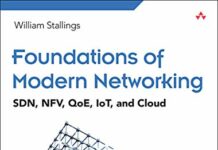
Ebook Info
- Published: 2004
- Number of pages: 559 pages
- Format: PDF
- File Size: 56.94 MB
- Authors: William Stallings
Description
Wireless Communications and Networks, 2e,provides one of the most up-to-date and accurate overviews of wireless principles, technology, and application. It is ideal for courses in wireless networking, wireless communications, wireless data communications or wireless technology in departments of Computer Science, Engineering, IT, and Continuing Education.The rapid growth of mobile telephone use, satellite services, and the wireless Internet are generating tremendous changes in telecommunications and networking. Combining very current technical depth with a strong pedagogy and advanced Web support, this new edition provides a comprehensive guide to wireless technologyexploring key topics such as technology and architecture, network types, design approaches, and the latest applications.
User’s Reviews
Editorial Reviews: Review “The author is focused on his topic, precise in his use of words, and balanced in his approach. Advantages to the text’s approach include the author’s ability to: a) explain complex concepts clearly and concisely, b) present detailed information succinctly, and c) use figures and tables to further explain difficult concepts.” — Anne M. Cox, “Austin Community College” “The author is focused on his topic, precise in his use of words, and balanced in his approach. Advantages to the text’s approach include the author’s ability to: a) explain complex concepts clearly and concisely, b) present detailed information succinctly, and c) use figures and tables to further explain difficult concepts.” Anne M. Cox, “Austin Community College” ” “The author is focused on his topic, precise in his use of words, and balanced in his approach. Advantages to the text’s approach include the author’s ability to: a) explain complex concepts clearly and concisely, b) present detailed information succinctly, and c) use figures and tables to further explain difficult concepts.” — Anne M. Cox, Austin Community College From the Back Cover Best-selling author, William Stallings, gives an up-to-date coverage of both wireless communications and wireless networks with new expanded coverage of Wi-Fi and WiMax. Designed for students and professionals, this text explores the key networking topics with a unique approach covering: technology and architecture, network design approaches, and types of networks and applications.DISTINGUISHING KEY FEATURESProvides an entire chapter on spread spectrum, which is pervasive in wireless technology today.Also provides an entire chapter on satellite communications. This topic remains an important area within wireless communications.Thorough coverage of cordless systems. This is an interesting and important new area that extends the traditional cordless telephone technology over greater distances and for greater numbers of users.Extensive coverage of fixed wireless access, also known as wireless local loop, and IEEE 802.16 standards. This has become a very important area for bringing high-speed access to subscribers in place of land lines.Devotes a whole chapter on Mobile IP Wireless Application Protocol (WAP). Wireless Internet and Web access are driving forces in the evolution of wireless technology and are a must have.Complete coverage of Wireless LANs, including IEEE 802.11 and Bluetooth. This is a broad and important area, and the book devotes three chapters to this realm. About the Author WILLIAM STALLINGS has made a unique contribution to understanding the broad sweep of technical developments in computer networking and computer architecture. He has authored 17 titles, plus revised editions, for a total of 41 books on various aspects of these subjects. Dr. Stallings has seven times received the award for best Computer Science Textbook of the Year from the Text and Academic Authors Association. He has created and maintains the Computer Science Student Resource Site atWilliamStallings.com/StudentSupport.html. He is also an independent consultant whose clients have included computer and networking manufacturers and customers, software development firms, and leading-edge government research institutions. Dr. Stallings holds a Ph.D. degree in Computer Science from M.I.T. and a B.S. from Notre Dame in electrical engineering. Excerpt. © Reprinted by permission. All rights reserved. OBJECTIVES Wireless technology has become the most exciting area in telecommunications and networking. The rapid growth of mobile telephone use, various satellite services, and now the wireless Internet and wireless LANs are generating tremendous changes in telecommunications and networking. This book explores the key topics in the field in the following general categories: Technology and architecture: There is a small collection of ingredients that serves to characterize and differentiate wireless communication and networking, including frequency band, signal encoding technique, error correction technique, and network architecture.Network type: This book covers the important types of wireless networks, including satellite, cellular, fixed wireless access, and wireless LANs.Design approaches: The book examines alternative design choices and assesses their relative merits.Applications: A number of key technologies and applications have been developed on top of wireless infrastructures, especially mobile IP and wireless Web access. Throughout, there is an emphasis on both technology and on standards. The book provides a comprehensive guide to understanding specific wireless standards, such as those promulgated by ITU and IEEE 802, as well as standards developed by other organizations. This emphasis reflects the importance of such standards in defining the available products and future research directions in this field. INTENDED AUDIENCE This book is intended for a broad range of readers who will benefit from an understanding of wireless communications and networks, and the associated technologies. This includes students and professionals in the fields of data processing and data communications, designers and implementers, and data communication and networking customers and managers. For the professional interested in this field, the book serves as a basic reference volume and is suitable for self-study. As a textbook, it is suitable for an advanced undergraduate or graduate course. It covers the material in the CS332 Wireless and Mobile Computing advanced course of the joint ACM/IEEE Computing Curricula 2001. The chapters and parts of the book are sufficiently modular to provide a great deal of flexibility in the design of courses. PLAN OF THE BOOK The book treats a number of advanced topics and provides a brief survey of the required elementary topics. For the reader with little or no background in data communications, Part One and the appendices cover a number of basic topics. The book is divided into four parts: Technical BackgroundWireless Communication TechnologyWireless NetworkingWireless LANs In addition, the book includes an extensive glossary, a list of frequently used acronyms, and a bibliography. Each chapter includes problems, suggestions for further reading, and a list of relevant Web sites. Each chapter also includes, for review, a list of key words and a number of review questions. INTERNET SERVICES FOR INSTRUCTORS AND STUDENTS There is a Web site for this book that provides support for students and instructors. The site includes links to other relevant sites, transparency masters of figures and tables from the book in PDF (Adobe Acrobat) format, PowerPoint slides, and sign-up information for the book’s Internet mailing list. The Web page is at WilliamStallings.com/WirelessWireless2e.html; see Section 1.8 for more information. An Internet mailing list has been set up so that instructors using this book can exchange information, suggestions, and questions with each other and with the author. As soon as typos or other errors are discovered, an errata list for this book will be available at WilliamStallings.com. I also maintain the Computer Science Student Resource Site at WilliamStallings.com/StudentSupport.html. WHAT’S NEW IN THE SECOND EDITION In the three years since the first edition of this book was published, the field has seen continued innovations and improvements. In this new edition, I try to capture these changes while maintaining a broad and comprehensive coverage of the entire field. To begin the process of revision, the first edition of this book was extensively reviewed by a number of professors who teach the subject. The result is that, in many places, the narrative has been clarified and tightened, and illustrations have been improved. Also, a number of new “field-tested” problems have been added. Beyond these refinements to improve pedagogy and user friendliness, the technical content of the book has been updated throughout, to reflect the ongoing changes in this exciting field. Every chapter has been revised. Highlights include the following: Minimum shift keying: MSK is a form of modulation that is found in some mobile communications systems. This material is now covered.CDMA2000: The first 3G (third generation) wireless system to be deployed commercially is known as CDMA2000 1xEV DO. A discussion of this important standard is included.WiMAX and IEEE 802.16x: Work on wireless local loop has evolved, including the introduction of the WiMAX specification to provide interoperability specifications for 802.16. Chapter 11 includes new material on 802.16, including the recent 802.16a standard.Orthogonal frequency division multiplexing: The popularity of OFDM is increasing and is used in a variety of local and wide area wireless standards. The material on OFDM has been updated and expanded.Wi-Fi and IEEE 802.11: The coverage of 802.11a and 802.11b has been expanded significantly, and treatment of 802.11g had been added.Data scrambling: Scrambling is a technique often used to improve signal quality. An overview of data scrambling is provided in Chapter 14.Wi-Fi protected access: WPA has replaced Wireless Equivalent Privacy (WEP) as the specification for providing security in wireless LANs. Chapter 14 provides coverage of WPA.IEEE 802.15 and personal area networks: The initial 802.15.1 standard provides an official specification for Bluetooth, which was covered in the first edition as well as this edition. This edition also covers two new standards: the 802.15.3 high-speed wireless PAN standard and the 802.15.4 low-speed wireless PAN standard.Trellis-coded modulation: TCM is a technique that provides for efficient use of bandlimited channels; it is described in Chapter 15. In addition, throughout the book, virtually every topic has been updated to reflect the developments in standards and technology that have occurred since the publication of the first edition. Read more
Reviews from Amazon users which were colected at the time this book was published on the website:
⭐This is the worst book I’ve ever used or read. I had to use three chapters of this book in one of my grad classes for the master of network and communication management, but I was very disappointed about the level of his writing and the more interesting thing is that the author seems to use copy and paste a lot from other documents, one of the chapters that I partially read was about the Bluetooth but I preferred to download the 802.15 standards from the IEEE web site and use it instead of using the book because it is concise and well organized not like the book which presents the material like a crosswords, what I found is that most of the material in that chapter was just a copy and paste from the IEEE standards without any explanation or added knowledge. Another interesting example is about the SIP and SDP; I needed to do a research for VOIP class specifically on SDP, therefore I searched some sites such as Cisco web site and the IETF RFCs and I found an article written by Stallings on Cisco web site and I compared it to RFC3261, guess what!! He copied most of the definitions and examples, even some of the diagrams from the RFC or other documents!!the links to Stallings article and to RFC3261 will not appear because Amazon remove them but the reader can search cisco web site and IETF and compare the two documents to judge.
⭐Its an expensive book that I got very cheap used, lest than 10% of the new price. Has coffee stains in it but no stray markings or dog ears so it is in descent condition and will serve its purpose.
⭐Chapter one dives right into signal theory and does a terrible job of it. Waveforms and formula’s abound with absolutly no description of what the formula’s signify. The text references figure’s of waveforms and formulas stating that at F3 blah blah blah and there is no F3 depicted on the diagram. I haven’t read beyond that chapter because I’m only using the book for a class and need the end of chapter questions, which I then google for the information. This book is total garbage.
⭐This book is okay. I need it for class. It’s not that comprehensive. It does provide a pretty good overview of wireless comm and networks. It’s a good investment if for a class.
⭐great book, it was pretty much brand new and the information was priceless. If you are taking a Control System class, this book will help you out a lot.
⭐This textbook arrive right on time, in new condition, and was priced right for me. My only complaint is that it feels more like an operating manual rather than a textbook. So much to learn in this field, the course required this and an additional 2 books because no one author could put it all in one book. Glad to have this in my reference library, however.
⭐grest book, good price, helped poor student like me save $$
⭐good Book.
Keywords
Free Download Wireless Communications and Networks 2nd Edition in PDF format
Wireless Communications and Networks 2nd Edition PDF Free Download
Download Wireless Communications and Networks 2nd Edition 2004 PDF Free
Wireless Communications and Networks 2nd Edition 2004 PDF Free Download
Download Wireless Communications and Networks 2nd Edition PDF
Free Download Ebook Wireless Communications and Networks 2nd Edition





